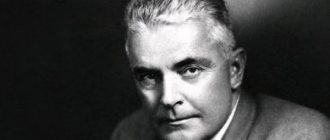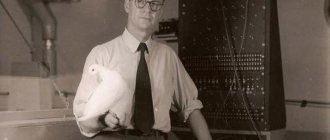Cognitive Behaviorism by Edward Tolman
General characteristics of classical behaviorism.
Behaviorism arose in the USA and was a reaction to the structuralism of V. Wundtai and E. Titchenera and American functionalism. Its founder was J. Watson (1878-1958), whose article “Psychology from the Point of View of a Behaviorist” (1913) marked the beginning of the direction. In it, the author criticized psychology for subjectivism, calling “... consciousness with its structural units, elementary sensations, sensory tones, attention, perception, representation in vague expressions alone,” as well as for practical uselessness. He declared the subject of behaviorism to be the study of behavior in an objective way and with the purpose of serving practice. “Behaviourism intends to become the laboratory of society.”
The philosophical basis of behaviorism is a fusion of positivism and pragmatism. As scientific prerequisites, J. Watson cited research on animal psychology, especially E. Thorndike, as well as the school of objective psychology. However, all these studies were, as Watson assessed them, “more a reaction to anthropomorphism than to psychology as a science of consciousness.”3 He also noted the influence of the works of I. P. Pavlov and V. M. Bekhterev.
Human behavior as the subject of behaviorism is all actions and words, both acquired and innate, what people do from birth to death. Behavior is any reaction (R)
in response to an external stimulus (5), through which the individual adapts. This is a set of changes in smooth and striated muscles, as well as changes in the glands that follow in response to an irritant. Thus, the concept of behavior is interpreted extremely broadly: it includes any reaction, including secretion of a gland and a vascular reaction. At the same time, this definition is extremely narrow, since it is limited only to what is externally observable: physiological mechanisms and mental processes are excluded from the analysis as unobservable. As a result, behavior is interpreted mechanistically, since it is reduced only to its external manifestations.
“The main task of behaviorism is to accumulate observations of human behavior in such a way that in each given case, given a given stimulus (or better yet, situation), the behaviorist can tell in advance what the reaction will be or, if a reaction is given, what situation will cause this reaction.” 4. These are the two problems of behaviorism. Watson classifies all reactions on two grounds: whether they are acquired or hereditary; internal (hidden) or external (external). As a result, reactions are distinguished in behavior: external or visible acquired (for example, playing tennis, opening a door, etc. motor skills); internal or hidden acquired (thinking, which in behaviorism means external speech); external (visible) hereditary (for example, grasping, sneezing, blinking, as well as reactions to fear, rage, love, i.e. instincts and emotions, but described purely objectively in terms of stimuli and reactions); internal (hidden) hereditary reactions of the endocrine glands, changes in blood circulation, etc., studied in physiology. Watson subsequently distinguished between instinctive and emotional reactions: “...if adaptations are caused by a stimulus of an internal nature and relate to the body of the subject, then we have an emotion, for example, blushing; if a stimulus leads to an adaptation of the organism, then we have an instinct—for example, grasping.”5
Observation of the newborn led to the conclusion that the number of complex unlearned reactions at birth and shortly after it is relatively small and cannot provide adaptation. The behaviorist does not find data confirming the existence of hereditary forms of behavior, such as crawling, climbing, pugnacity, or hereditary abilities (musical, artistic, etc.) - In practice, behavior is the result of learning. He believes in the omnipotence of education. “Give me a dozen healthy, strong children and people, and I will undertake to make each of them a specialist of my choice: a doctor, a businessman, a lawyer, and even a beggar and a thief, regardless of their talents, inclinations, tendencies and abilities, as well as profession and the races of their ancestors"6. Therefore, skill and learning become the main problem of behaviorism. Speech and thinking are considered as types of skills. A skill is an individually acquired or learned action. It is based on elementary movements that are innate. A new or learned element in a skill is the tying together or combining of separate movements in such a way as to produce a new activity. Watson described the process of developing a skill and built a learning curve (using the example of learning archery). At first, random, experimental movements predominate, with many mistakes and only a few successful ones. Initial accuracy is low. Improvement is fast for the first 60 shots, then slower. Periods without improvement are observed - these sections of the curve are called “plateaus”. The curve ends at the physiological limit characteristic of the individual. Successful movements are associated with greater changes in the body, so that they are better maintained and physiologically “therefore tend to be consolidated.
Retention of skills constitutes memory. In contradiction to the refusal to study unobservable mechanisms of behavior, Watson puts forward a hypothesis about such mechanisms, which he calls the principle of conditioning. Calling all hereditary reactions unconditioned reflexes, and acquired ones conditioned, J. Watson argues that the most important condition for the formation of a connection between them is the simultaneity in the action of the unconditioned and conditioned stimuli, so that stimuli that initially did not cause any reaction now begin to cause it. It is assumed that the connection is the result of a switching of excitation in the central authority on the path of a stronger, i.e., unconditioned stimulus. However, the behaviorist does not concern himself with this central process, limiting himself to observing the relationship of the response to all new stimuli.
In behaviorism, the process of skill formation and learning is interpreted mechanistically. Skills are developed through blind trial and error and are an unguided process. Here one of the possible paths is presented as the only and mandatory7. Despite these limitations, Watson's concept laid the foundation for a scientific theory of the process of motor skill formation and learning in general.
7 There is another way, which is based on managing the process of skill formation: a system of conditions necessary for an action is identified, and its implementation is organized focusing on these conditions.
By the mid-20s. behaviorism became widespread in America, which allowed E. Boring to write: “... it would not be an exaggeration to say that at present behaviorism is a typical American psychology, despite the fact that perhaps the majority of American psychologists will refuse to call themselves behaviorists"8. At the same time, it became increasingly clear to researchers that excluding the psyche leads to an inadequate interpretation of behavior. This was pointed out by E. Tolman in his criticism of Watson, calling his approach molecular9. Indeed, if we exclude its motivational-cognitive components from behavior, it is impossible to explain the integration of individual reactions into a particular act or activity such as “a person builds a house,” swims, writes a letter, etc. J. Watson’s statement that The behaviorist is interested in the behavior of the whole person, is in no way supported by his mechanistic atomistic position and even comes into conflict with it, which he himself admitted. “The behaviorist in his scientific activity uses tools, the existence of which he denies both in his object and in himself.” Due to the mechanism in the interpretation of behavior, a person in behaviorism acts as a reactive being, his active conscious activity is ignored. “Environmental conditions influence us in such a way that at a given moment, under given conditions, any object can only evoke a strictly corresponding and conditioned course of action”10. This does not take into account the qualitative changes that occur in behavior with the transition to humans: data obtained in animal studies are transferred to humans. Watson emphasized that he wrote this work and considered man as an animal organism. Hence naturalism in the interpretation of man. Man “...is an animal distinguished by verbal behavior”11.
The hidden basis of behaviorism is the identification of the psyche with its introspective understanding in the psychology of consciousness. According to Vygotsky and Rubinstein, ignoring consciousness, the psyche, instead of rebuilding the introspectionist concept of consciousness, is the essence of Watson's radical behaviorism. Obviously, it is impossible to base psychology on the denial of the psyche. At the same time, Watson's historical merit is the study of behavior and the acute formulation of the problem of an objective approach in psychology. Also important is the task he put forward to control human behavior, the focus of scientific research on connections with practical problems. However, due to the mechanistic approach to man as a reacting organism, the implementation of this task receives
behaviorism is a direction that dehumanizes a person: management begins to be identified with the manipulation of the individual.
Back in 1913, W. Hunter, in experiments with delayed reactions, showed that the animal reacts not only directly to the stimulus: behavior involves processing the stimulus in the body. This posed a new problem. An attempt to overcome the simplified interpretation of behavior according to the stimulus-response scheme by introducing internal processes that unfold in the body under the influence of a stimulus and influence the reaction was made by various variants of neobehaviorism. It also develops new models of conditioning, and the results of research are widely disseminated in various areas of social practice. The foundations of neobehaviorism were laid by E. Tolman (1886-1959). In his book, Purposeful Behavior in Animals and Man (1932), he showed that experimental observations of animal behavior do not correspond to Watson's molecular understanding of stimulus-response behavior. Behavior, according to Tolman, is a molar phenomenon, that is, a holistic act that is characterized by its own properties: goal orientation, intelligibility, plasticity, selectivity, expressed in the willingness to choose means leading to the goal in shorter ways. The introduction of the concepts of goal (intention) and field into the characteristics of behavior reflects Tolman’s position in relation to other directions in psychology: he recognized the compatibility of behaviorism with Gestalt psychology and depth psychology. Convinced of the complexity of the determination of behavior, Tolman distinguished three types of its determinants: independent variables (initial causes of behavior), stimuli and the initial physiological state of the organism; abilities, i.e. species properties of an organism; intervening internal variables - intentions (goals) and cognitive processes. Coming out against the subjectivist interpretation of these formations in the spirit of old mentalism, Tolman made the interfering variables the subject of his own experimental research. In experiments on latent learning, vicarious trial and error, hypotheses, etc., the concept of a “cognitive map” was formulated. A cognitive map is a structure that develops in the animal’s brain as a result of processing external influences. It includes a complex significative structure of the relationship between stimuli and goals (sign - gestalt) and determines the behavior of the animal in the situation of the actual task. The combination of such maps allows one to adequately navigate the situation of life tasks in general, including for a person. Despite all the reservations associated with attempts to avoid mentalism, in fact, as a result of the introduction of intermediate variables, behavior actually receives a psychological characteristic. Tolman extended the findings obtained on animals to humans, thereby sharing Watson’s biologizing positions.
A major contribution to the development of neo-behaviourism was made by K. Hull (1884-1952). His hypothetico-deductive theory of behavior was formed under the influence of the ideas of Pavlov, Thorndike, and Watson. His own experimental research was carried out in the field of learning in animals. Like Watson's theory, Hull's theory does not take into account the factor of consciousness, but unlike Watson, instead of the stimulus-reaction scheme, Hull introduces the formula proposed back in 1929 by Woodworth, stimulus-organism-reaction, where the organism is some invisible processes occurring within it processes. They can be described objectively, like stimulus and response: these are the results of previous learning (a skill, in Hull’s terminology), a deprivation regime, the derivative of which is drive, drug injections, etc. Behavior begins with stimulation from the external world or from a state of need and ends with a reaction . “The evolution of organic processes has led to the appearance of a form of nervous system in higher organisms which, under the influence of need and muscular activity, will cause, without previous training, those changes in movements that would have the potential to nullify the need. We call this kind of activity behavior”2. Using logical and mathematical analysis, Hull sought to identify the relationship between these variables, stimuli, and behavior. He formulated the laws of behavior—theoretical postulates that establish connections between the main variables that determine behavior. Hull considered rudeness to be the main determinant of behavior. The need causes the activity of the organism, its behavior. The strength of the reaction (reaction potential) depends on the strength of the need. Need determines the nature of behavior that differs in response to different needs. The most important condition for the formation of a new connection, according to Hull, is the contiguity of stimulus, reactions and reinforcement, which reduces the need. Thus Hull accepts Thorndike's law of effect. The strength of the connection (response potential) depends on the number of reinforcements and is a function of it, and it also depends on the delay of reinforcement. Hull emphasizes the crucial role of reinforcement in the formation of new connections. He is responsible for the thorough theoretical and experimental development and mathematical calculation of the dependence of the reaction on the nature of reinforcement (partial, intermittent, constant) and on the time of its presentation. These learning factors were complemented by principles. The fact that the animal behaved differently in different sections of the path in the process of developing a skill was revealed in experiments with mazes (the speed of going around dead ends at the beginning and at the end of the maze is not the same, and in the second case it is greater; the number of errors in sections far from the goal is greater than at the end of the maze; the speed of movement in a maze when going through it again is greater at the end of the path than at the beginning) is called the goal gradient. The phenomena described by Hull testified to the holistic—molar—nature of behavior. In the principle of the target gradient, Hull saw the similarity of his concept with the doctrine of field forces by K. Lewin. The integration of individual motor acts into a holistic behavioral act is facilitated by anticipatory reactions or anticipatory responses to irritation - experimentally discovered phenomena of partial responses that contribute to finding actions leading to the goal. Thus, it was observed that in the process of training the animal goes less and less deeply into dead ends or even only slows down its movements around them, just as in the process of developing a conditioned reflex there comes a moment when, before the appearance of danger, animals carry out protective, i.e., expedient, actions only when there is a danger signal. Hull considered anticipatory reactions as functional equivalents of ideas, goals, and intentions.
The experience of a mathematical approach to describing behavior in the Hull system influenced the subsequent development of mathematical theories of learning. Under the direct influence of Hull, N. E. Miller and O. G. Maurer began to study issues of learning. They created their own concepts, staying within the framework of traditional reinforcement theory, but using Hull's formal approach. K-Spence and his students A. Amsel, F. Logan continued the development of Hull's theoretical ideas.
Another version of the concepts of behavior that includes intermediate mechanisms in the structure of behavior is the theory of subjective behaviorism, which was proposed by D. Miller, Y. Galanter, K. Pribram. Under the influence of the development of computers and by analogy with the programs embedded in them, they postulated mechanisms and processes within the body that mediate the response to a stimulus and the reality of which is beyond doubt. They named the image and the plan as such authorities connecting stimulus and reaction. “Image is all the accumulated and organized knowledge of an organism about itself and about the world in which it exists... when using this term, we mean, in
basically the same type of representation that other cognitive theorists have demanded. It includes everything that the organism has acquired - its assessments along with facts - organized with the help of those concepts, images or relationships that it was able to develop: "1*. “A plan is any hierarchically constructed process of an organism capable of controlling the order in which any sequence of operations should be performed”14. The image is informative, and the plan is algorithmic aspects of the organization of behavior. Throughout, the authors point out the analogies of these formations to computer programs. Behavior is viewed as a series of movements, and a person is viewed as a complex computing machine. The strategy of the plan is built on the basis of tests carried out in the conditions created by the image. A test is the basis of a holistic process of behavior, with the help of which it becomes clear that the operational phase (operate) is carried out correctly. Thus, the concept of behavior includes the idea of feedback. Each operation is preceded by a test. A unit of behavior is described according to the scheme: T—O—T—E (result).
“...The T—O—T—E scheme states that the operations performed by the body are constantly regulated by the results of various tests.” The position of subjective behaviorism reflects the general trend in the development of behaviorism, when, in the words of the authors themselves, almost every behaviorist smuggles into his system one or another type of invisible phenomena - internal reactions, impulses, incentives, etc. ... this is what everyone does for one simple reason the reason that without this it is impossible to understand the meaning of behavior”,5. However, the authors never tire of emphasizing that these invisible phenomena - “intermediate variables” - should not be understood in the spirit of psychological concepts of subjective introspective psychology. Interpreting them by analogy with the design of calculating machines cannot be considered satisfactory, because in a machine, images and plans are material formations, the action of which occurs automatically, while the psyche appears as a necessary condition for the subject to perform an action in new circumstances. The authors anticipate that their explanation may be regarded as crude mechanistic analogies and hypotheses, but nevertheless consider them to accurately reflect the essence of behavior. In general, subjective behaviorism in the interpretation of behavior remains within the framework of mechanistic behaviorist methodology and does not reach a real explanation of the regulation of human behavior.
Meanwhile, outstanding psychologists appeared in the circle of behaviorists who questioned this postulate. The first of them was a professor at the University of Berkeley (California), an American, Edward Tolman (1886-1959), according to whom the formula of behavior should consist not of two, but of three members, and therefore look like this: stimulus (independent variable) - intermediate variables - dependent variable (response).
The middle link (intermediate variables) is nothing more than mental moments inaccessible to direct observation: expectations, attitudes, knowledge.
Following the behaviorist tradition, Tolman experimented with rats looking for a way out of a maze. The main conclusion from these experiments was that, based on the behavior of animals strictly controlled by the experimenter and objectively observed by him, it can be reliably established that this behavior is controlled not by the stimuli that are acting on them at the moment, but by special internal regulators. Behavior is preceded by a kind of expectations, hypotheses, and cognitive “maps.” The animal builds these “maps” itself. They guide him in the labyrinth. From them it, being launched into the labyrinth, learns “what leads to what.” The position that mental images serve as a regulator of action was substantiated by Gestalt theory. Taking her lessons into account, Tolman developed his own theory, called cognitive behaviorism.
Tolman outlined his ideas in the books “Target Behavior in Animals and Humans” and “Cognitive Maps in Rats and Humans.” He carried out experimental work mainly on animals (white rats), believing that the laws of behavior are common to all living beings, and can be most clearly and thoroughly traced at the elementary levels of behavior.
The results of Tolman’s experiments, presented in his main work “Goal-directed behavior in animals and humans” (1932), forced a critical rethinking of the cornerstone scheme of SR (“stimulus-response”) behaviorism.
The very idea of goal-directed behavior contradicted the programmatic guidelines of the founder of behaviorism, Watson. For classical behaviorists, goal-directed behavior implies the assumption of consciousness.
To this Tolman stated that it does not matter to him whether an organism has consciousness or not. As befits a behaviorist, he focused on external, observable reactions. He proposed that the causes of behavior included five major independent variables: environmental stimuli, psychological drives, heredity, prior learning, and age. The behavior is a function of all these variables, which can be expressed by a mathematical equation.
Between the observed independent variables and the resulting behavior, Tolman introduced a set of unobservable factors, which he called intervening variables. These intervening variables are actually determinants of behavior. They represent those internal processes that link the stimulus situation to the observed response.
Thus, the SR formula should be read as SO R. Intermediate variables are everything that is associated with O, that is, with the organism, and forms a given behavioral response to a given irritation.
However, while remaining in the position of behaviorism, Tolman was aware that since intermediate variables are not subject to objective observation, they are of no practical use to psychology unless they can be linked to experimental (independent) and behavioral (dependent) variables.
A classic example of an intervening variable is hunger, which cannot be observed in a test subject (whether animal or human). Nevertheless, hunger can be quite objectively and accurately linked to experimental variables, for example, to the duration of the period of time during which the body did not receive food.
In addition, it can be linked to an objective response or to a behavioral variable, such as the amount of food eaten or the rate of food absorption. Thus, this factor becomes available for quantitative measurement and experimental manipulation.
In theory, intervening variables have proven to be a very useful construct. However, the practical implementation of this approach required such enormous work that Tolman eventually abandoned all hope of “compiling a complete description of even one intermediate variable.”
The results obtained in the experiments forced Tolman to abandon the law of effect, which was fundamental for the entire behavioral doctrine, discovered by Thorndike. In his opinion, reinforcement has a rather weak effect on learning.
Tolman proposed his own cognitive theory of learning, believing that repeated performance of the same task strengthens the emerging connections between environmental factors and the organism's expectations. In this way, the body learns about the world around it. Tolman called such connections created by learning Gestalt signs.
Historians of science make a bold assumption that the father of behaviorism, John Watson, suffered from a specific disorder - an-ideism, that is, he was completely devoid of imagination, which forced him to interpret all observed phenomena purely literally.
Tolman cannot be denied creative imagination, however, he also based his theoretical reasoning on objectively observable phenomena. What did he see in his experiments that made him go beyond Watson's ideas?
Here is a rat running through a maze, randomly trying either successful (you can move on) or unsuccessful (dead end) moves. Finally she finds food. During subsequent passages of the maze, the search for food gives the rat's behavior purposefulness.
Each branching move comes with some expectations. The rat comes to “understand” that certain signs associated with the fork do or do not lead to the place where the desired food is located.
If the rat's expectations are met and it actually finds food, then the gestalt sign (that is, the sign associated with some choice point) receives reinforcement. Thus, the animal develops a whole network of gestalt signs at all choice points in the maze. Tolman called this a cognitive map.
This pattern represents what the animal has learned, not just a collection of some motor skills. In a certain sense, the rat acquires a comprehensive knowledge of its labyrinth, and in other conditions - of a different environment around it. Her brain develops something like a field map that allows her to move in the right direction without being limited to a fixed set of learned body movements.
In a classic experiment described in many textbooks, Tolman’s ideas found clear and convincing confirmation. The maze used in this experiment was cross-shaped. Rats of the same group always found food in the same place, even if, in order to get to it, they sometimes had to turn left rather than right at different entry points into the maze. The motor reactions, of course, were different, but the cognitive map remained the same.
The rats of the second group were placed in such conditions that they had to repeat the same movements each time, but the food was in a new place each time.
For example, starting at one end of the maze, a rat found food only by turning right at a certain fork; if the rat was launched from the opposite side, then in order to get to the food, it still had to turn to the right.
The experiment showed that the rats of the first group—those who “studied” and “learned” the general scheme of the situation—orientated much better than the rats of the second group, which reproduced learned reactions.
Tolman suggested that something similar occurs in humans. A person who has managed to navigate a certain area well can easily go from one point to another along different routes, including unfamiliar ones.
Another experiment examined latent learning, that is, learning that cannot be observed while it is actually happening.
A hungry rat was placed in a maze and allowed to roam freely. For some time the rat did not receive any food, that is, no reinforcement occurred. Tolman was interested in whether any learning takes place in such an unreinforced situation.
Finally, after several non-reinforced trials, the rat was given the opportunity to find food. After this, the speed of completing the maze increased sharply, which showed the presence of some learning during the period of absence of reinforcement. This rat's performance very quickly reached the same level as that of rats that received reinforcement on every trial.
It would be wrong to perceive Tolman as a “rat mentor”, far from human problems. His article, revealingly titled “Cognitive Maps in Rats and Humans” (also available in Russian translation), became not only a collection of evidence against the S ® R scheme, but also a passionate appeal to reduce the level of frustration, hatred and intolerance generated in society by narrow cognitive maps.
Beck's cognitive psychotherapy
In this article, for a number of reasons, we decided to dwell in more detail on Beck’s cognitive therapy (CT).
Firstly, in our opinion, it is cognitive psychotherapy that integrates the most important achievements of other cognitive-behavioral approaches. Moreover, the two-level scheme of cognitive processes proposed by Beck makes it possible to integrate cognitive principles with the psychodynamic approach. In this scheme, Beck identifies actually dynamic (moving, changing) and structural (more stable and permanent) components of the cognitive process. Dynamic components are the flow of thoughts or, in the language of behaviorism, internal behavior. Structural components are stable cognitive formations that represent beliefs, beliefs and attitudes. These components determine the nature and content of the dynamic components or the flow of thoughts about oneself and about the world. Thoughts, in turn, determine a person’s emotional state and behavior. Thus, in order to change behavior and inappropriate emotional states, it is necessary to modify thinking. The difficulty is that many thoughts are semi-conscious in nature and cannot be directly detected and controlled (Beck calls them automatic thoughts). Beliefs and beliefs formed in previous experiences can also be unconscious. Therefore, the techniques developed by Beck are aimed primarily at identifying, recognizing and modifying the so-called dysfunctional thoughts and beliefs that lead to painful conditions and inappropriate reactions. These fundamental ideas of cognitive psychotherapy clearly contradict one of the main theses of behaviorism about the external determination of behavior. Finally, the study of the sources of formation of structural components inevitably leads to the concept of early experience in which they were formed, which means a direct connection with the psychodynamic approach, where the concept of early experience is one of the central ones. The integrating function of the two-level model of cognitive processes proposed by Beck is illustrated by the following diagram.
Cognitive psychotherapy is a bridge between behaviorism and psychoanalysis
In our opinion, the integrative nature of cognitive psychotherapy is its most important advantage, which allows us to string a variety of techniques and approaches onto the core idea of modifying dysfunctional thoughts and beliefs. Another advantage of the two-level scheme is that it sets a clear strategy for psychotherapeutic work - from more superficial, situationally unfolding thoughts (a dynamic component of the cognitive process) to deep, stable structural formations.
Another equally important advantage of cognitive psychotherapy compared to other cognitive-behavioral approaches is the presence of a detailed theory of mental pathology: for almost all major mental disorders, psychological models have been developed and the main targets of psychotherapeutic influence have been identified, and the techniques and techniques most adequate to these targets have been described.
The undoubted advantage of cognitive psychotherapy compared to psychodynamic approaches is its short-term nature and cost-effectiveness. At the same time, numerous controlled studies have proven the high effectiveness of cognitive psychotherapy for a wide variety of disorders.
In Russia, cognitive psychotherapy has not yet become widespread, which is partly due to the lack of a flow of cognitively oriented “missionary trainers” from the West. At one time, the spread of psychoanalysis, psychodrama, Gestalt therapy, and neurolinguistic programming in Russia became possible thanks to a series of training programs brought here by Western specialists. Compensating for the gap that has arisen in relation to cognitive psychotherapy seems to be very important, since this approach has proven to be highly effective in the treatment of various disorders and is distinguished by its close connection with modern scientific psychology. Cognitive psychotherapy, with its structure, can greatly help compensate for the chaos that is often characteristic of the Russian client. At the same time, the central link in the process of cognitive psychotherapy is reflection, which leads to co-consciousness of basic, initial ideas about oneself and the world, which is in tune with the existentially oriented Russian mentality. This approach is especially highly effective in the treatment of emotional disorders, the incidence of which, according to epidemiologists, has increased significantly (which indirectly confirmed by the expansion of the corresponding clusters in modern classifications ICD-IO, DSM-IVr), makes, in our opinion, appropriate to popularize CT in Russia.








